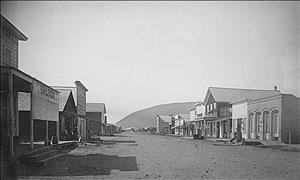On December 17, 1884, the tracks of the Northern Pacific Railway's Cascade Branch reach the vicinity of Yakima City, then a thriving county seat with around 500 inhabitants. Residents do not celebrate, however, because the company has just announced that its trains will not stop in the city. Instead, the Northern Pacific builds a depot at a new townsite it has platted about five miles farther northwest. Within a year, the city moves to the new site.
In 1884, the Northern Pacific began building its Cascade Branch from Pasco and Kennewick on the Columbia River up the Yakima Valley and across the Cascade Mountains at Stampede Pass to Puget Sound. By December, the line was constructed from the Columbia to within a few miles of the existing Yakima City. The community, which took its name from the Yakama Indians who lived in the region, was established in 1861. By 1884, it was the county seat of Yakima County, and boasted three churches, a bank, hotels, stores and fine homes.
The residents' plans to celebrate the railroad's arrival were cut short when the Northern Pacific announced that trains would not be stopping in the city, but at a depot to be built at a townsite platted by the railroad almost five miles farther up the Yakima River. On December 17, 1884, the railroad reached Yakima City. However, as announced, no depot was built, and over the next two months the tracks were extended to the new townsite, called North Yakima.
A Town on the Move
The Territory of Washington sued the Northern Pacific to force the railroad to establish a depot in Yakima City, and actually won a court decision. However, many local businessmen concluded that the existing site was too limited for hoped-for future growth, and gradually began moving their premises to North Yakima. The Northern Pacific hastened this process by offering to give landowners as many lots in the new town as they had in the old one, and even to pay the cost of moving buildings. Through the winter and spring of 1884-1885, more than 100 buildings were moved on trucks and rollers from their original locations to the new site. Reportedly, establishments including hotels and a bank remained open for business along the way while being moved.
By May 1885, the press reported that Yakima City was "a thing of the past" (Lewty, 41). This was something of an exaggeration. Yakima City retained its name, and the new town, which became the county seat, was incorporated in 1886 as North Yakima. In 1917, the state legislature changed the name of Yakima City to Union Gap, and shortened "North Yakima" to Yakima (the latter change did not take effect until January 1, 1918, "to allow residents of the big East Side community to make ready" ["North Yakima to Shorten Name ..."]).

